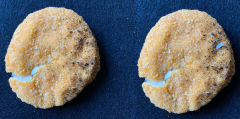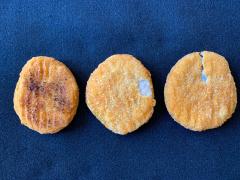Market Poultry - Breaded boneless processed poultry
The 4-H poultry judging contest includes a class on breaded, boneless, processed poultry products. Boneless further processed poultry meat products are common in retail markets (e.g., precooked, poultry meat patties, tenders, nuggets, or other boneless products). The products will be displayed singly or in groups of three in order to help determine uniformity.
Criteria for evaluation of boneless, breaded products will include:
- Coating defect
- Consistency of shape/size
- Cluster/aggregation of products
- Completeness of products
- Evidence of foreign material
1. Coating defects
Coverage
The thickness and evenness of the breading and how well it adheres to the surface of the meat are the most important factors when determining coating coverage. The product surface should be completely covered with a uniform texture and appearance. This defect must be a continuous void that exceeds the allowed limit of breading voids: >¼ inch on tenders and nuggets; and >½ inch on patties. Voids on a single product are not added together. If three pieces are shown, the amount of void is not additive over the three pieces.
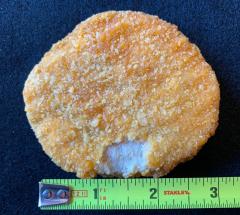


Color
Boneless poultry products are breaded for taste and customer appeal. Typically, a golden-brown color is expected. Subtle differences are normal during the production of breaded products. You should expect the color to be uniform across all products displayed in a group as established by two or more of the products displayed. If one of the products is noticeably darker or lighter than the other two products, it is a color defect. For single items, the color should be uniform across the entire item and should not contain dark, burnt areas, or other contrasting colors in the coating of the product.
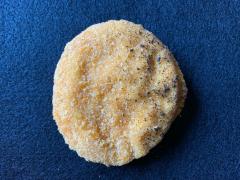
2. Consistency of shape/size
The inconsistent size or shape of the product is based on the uniformity of a product line. There are many shapes and sizes of boneless chicken products. For example, nuggets are processed in a variety of shapes from stars to dinosaurs. Slight variation is expected, however, substantial differences or variations in shape and size of products can affect consumer preferences and cook times. Standard product size and shape should be determined in each group by using two or more pieces of similar size. If there are clear differences in the uniformity of product size or shape in the sample, or if the product is folded prior to breading or while processing and the product take on a shape not consistent with the other samples, record “Consistency of size/shape defect'.
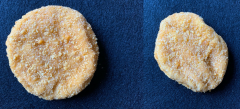
3. Cluster/Aggregate of Products
When breading further processed products, it is possible for two or more pieces of product to become overlapped and breaded together. This is a defect since the products that are overlapped may not cook properly. When selecting a “Cluster” defect, the product must appear to be fused together with breading and not just touching each other or overlapping when displayed.
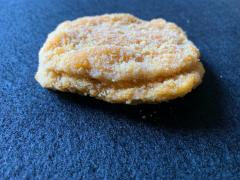
4. Completeness of product
Broken or incomplete products are visible in two ways. An incomplete break is when a product has a break or tear in the meat that is clearly visible. A complete break is when the product is broken apart and displayed in two pieces or as part of the piece. If the complete break is evident and the only part is displayed it should still be recorded as “Completeness of product.” Do not record this type of defect as “Inconsistent Shape and Size” or “Coating Defect” when it is evident that it is part of a broken product and the break is what caused the product to take on these other defects.
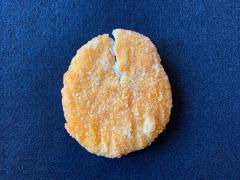
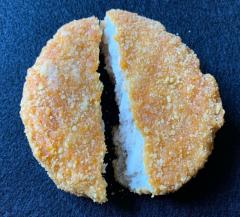
5. Evidence of Foreign Material
Foreign materials are any non-food objects, such as feathers, plastic, metal, rubber, glass, and wood.
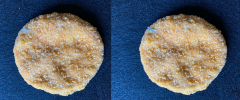
OVERALL
Since the contestants cannot handle the product, they should only evaluate the portions that are fully visible. Be careful not to create multiple defects when one defect causes the other factors by the nature of the main defect. For example, if a patty is broken in half and only one half is displayed, you should record “Broken/Incomplete” as the defect even though it is a different shape or may be missing some breading where the break occurred. You do not record the “Coating Defect” or “Shape/Size Defect” since they are a result of the broken patty.
